Vladislav Golyanik
MPI for Informatics, SIC
Quantum-enhanced Computer Vision: Going Beyond Classical Algorithms
Oct 08, 2025Abstract:Quantum-enhanced Computer Vision (QeCV) is a new research field at the intersection of computer vision, optimisation theory, machine learning and quantum computing. It has high potential to transform how visual signals are processed and interpreted with the help of quantum computing that leverages quantum-mechanical effects in computations inaccessible to classical (i.e. non-quantum) computers. In scenarios where existing non-quantum methods cannot find a solution in a reasonable time or compute only approximate solutions, quantum computers can provide, among others, advantages in terms of better time scalability for multiple problem classes. Parametrised quantum circuits can also become, in the long term, a considerable alternative to classical neural networks in computer vision. However, specialised and fundamentally new algorithms must be developed to enable compatibility with quantum hardware and unveil the potential of quantum computational paradigms in computer vision. This survey contributes to the existing literature on QeCV with a holistic review of this research field. It is designed as a quantum computing reference for the computer vision community, targeting computer vision students, scientists and readers with related backgrounds who want to familiarise themselves with QeCV. We provide a comprehensive introduction to QeCV, its specifics, and methodologies for formulations compatible with quantum hardware and QeCV methods, leveraging two main quantum computational paradigms, i.e. gate-based quantum computing and quantum annealing. We elaborate on the operational principles of quantum computers and the available tools to access, program and simulate them in the context of QeCV. Finally, we review existing quantum computing tools and learning materials and discuss aspects related to publishing and reviewing QeCV papers, open challenges and potential social implications.
Quantum Visual Fields with Neural Amplitude Encoding
Aug 14, 2025Abstract:Quantum Implicit Neural Representations (QINRs) include components for learning and execution on gate-based quantum computers. While QINRs recently emerged as a promising new paradigm, many challenges concerning their architecture and ansatz design, the utility of quantum-mechanical properties, training efficiency and the interplay with classical modules remain. This paper advances the field by introducing a new type of QINR for 2D image and 3D geometric field learning, which we collectively refer to as Quantum Visual Field (QVF). QVF encodes classical data into quantum statevectors using neural amplitude encoding grounded in a learnable energy manifold, ensuring meaningful Hilbert space embeddings. Our ansatz follows a fully entangled design of learnable parametrised quantum circuits, with quantum (unitary) operations performed in the real Hilbert space, resulting in numerically stable training with fast convergence. QVF does not rely on classical post-processing -- in contrast to the previous QINR learning approach -- and directly employs projective measurement to extract learned signals encoded in the ansatz. Experiments on a quantum hardware simulator demonstrate that QVF outperforms the existing quantum approach and widely used classical foundational baselines in terms of visual representation accuracy across various metrics and model characteristics, such as learning of high-frequency details. We also show applications of QVF in 2D and 3D field completion and 3D shape interpolation, highlighting its practical potential.
HumanOLAT: A Large-Scale Dataset for Full-Body Human Relighting and Novel-View Synthesis
Aug 12, 2025Abstract:Simultaneous relighting and novel-view rendering of digital human representations is an important yet challenging task with numerous applications. Progress in this area has been significantly limited due to the lack of publicly available, high-quality datasets, especially for full-body human captures. To address this critical gap, we introduce the HumanOLAT dataset, the first publicly accessible large-scale dataset of multi-view One-Light-at-a-Time (OLAT) captures of full-body humans. The dataset includes HDR RGB frames under various illuminations, such as white light, environment maps, color gradients and fine-grained OLAT illuminations. Our evaluations of state-of-the-art relighting and novel-view synthesis methods underscore both the dataset's value and the significant challenges still present in modeling complex human-centric appearance and lighting interactions. We believe HumanOLAT will significantly facilitate future research, enabling rigorous benchmarking and advancements in both general and human-specific relighting and rendering techniques.
Attention (as Discrete-Time Markov) Chains
Jul 23, 2025Abstract:We introduce a new interpretation of the attention matrix as a discrete-time Markov chain. Our interpretation sheds light on common operations involving attention scores such as selection, summation, and averaging in a unified framework. It further extends them by considering indirect attention, propagated through the Markov chain, as opposed to previous studies that only model immediate effects. Our main observation is that tokens corresponding to semantically similar regions form a set of metastable states, where the attention clusters, while noisy attention scores tend to disperse. Metastable states and their prevalence can be easily computed through simple matrix multiplication and eigenanalysis, respectively. Using these lightweight tools, we demonstrate state-of-the-art zero-shot segmentation. Lastly, we define TokenRank -- the steady state vector of the Markov chain, which measures global token importance. We demonstrate that using it brings improvements in unconditional image generation. We believe our framework offers a fresh view of how tokens are being attended in modern visual transformers.
Outlier-Robust Multi-Model Fitting on Quantum Annealers
Apr 18, 2025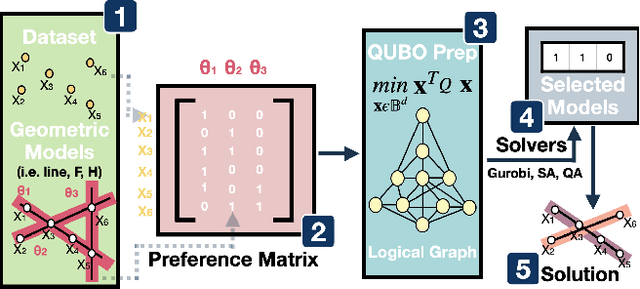

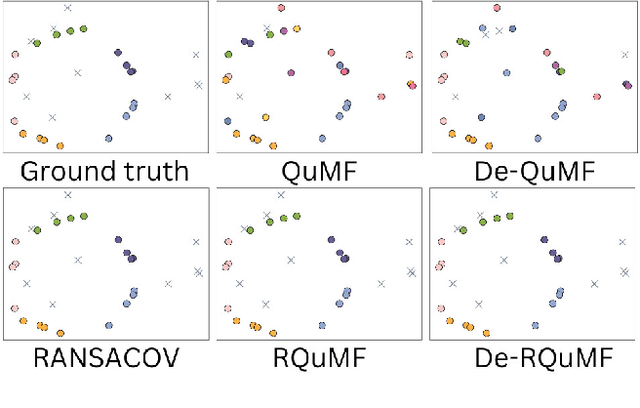

Abstract:Multi-model fitting (MMF) presents a significant challenge in Computer Vision, particularly due to its combinatorial nature. While recent advancements in quantum computing offer promise for addressing NP-hard problems, existing quantum-based approaches for model fitting are either limited to a single model or consider multi-model scenarios within outlier-free datasets. This paper introduces a novel approach, the robust quantum multi-model fitting (R-QuMF) algorithm, designed to handle outliers effectively. Our method leverages the intrinsic capabilities of quantum hardware to tackle combinatorial challenges inherent in MMF tasks, and it does not require prior knowledge of the exact number of models, thereby enhancing its practical applicability. By formulating the problem as a maximum set coverage task for adiabatic quantum computers (AQC), R-QuMF outperforms existing quantum techniques, demonstrating superior performance across various synthetic and real-world 3D datasets. Our findings underscore the potential of quantum computing in addressing the complexities of MMF, especially in real-world scenarios with noisy and outlier-prone data.
Thin-Shell-SfT: Fine-Grained Monocular Non-rigid 3D Surface Tracking with Neural Deformation Fields
Mar 25, 2025Abstract:3D reconstruction of highly deformable surfaces (e.g. cloths) from monocular RGB videos is a challenging problem, and no solution provides a consistent and accurate recovery of fine-grained surface details. To account for the ill-posed nature of the setting, existing methods use deformation models with statistical, neural, or physical priors. They also predominantly rely on nonadaptive discrete surface representations (e.g. polygonal meshes), perform frame-by-frame optimisation leading to error propagation, and suffer from poor gradients of the mesh-based differentiable renderers. Consequently, fine surface details such as cloth wrinkles are often not recovered with the desired accuracy. In response to these limitations, we propose ThinShell-SfT, a new method for non-rigid 3D tracking that represents a surface as an implicit and continuous spatiotemporal neural field. We incorporate continuous thin shell physics prior based on the Kirchhoff-Love model for spatial regularisation, which starkly contrasts the discretised alternatives of earlier works. Lastly, we leverage 3D Gaussian splatting to differentiably render the surface into image space and optimise the deformations based on analysis-bysynthesis principles. Our Thin-Shell-SfT outperforms prior works qualitatively and quantitatively thanks to our continuous surface formulation in conjunction with a specially tailored simulation prior and surface-induced 3D Gaussians. See our project page at https://4dqv.mpiinf.mpg.de/ThinShellSfT.
Bring Your Rear Cameras for Egocentric 3D Human Pose Estimation
Mar 14, 2025Abstract:Egocentric 3D human pose estimation has been actively studied using cameras installed in front of a head-mounted device (HMD). While frontal placement is the optimal and the only option for some tasks, such as hand tracking, it remains unclear if the same holds for full-body tracking due to self-occlusion and limited field-of-view coverage. Notably, even the state-of-the-art methods often fail to estimate accurate 3D poses in many scenarios, such as when HMD users tilt their heads upward (a common motion in human activities). A key limitation of existing HMD designs is their neglect of the back of the body, despite its potential to provide crucial 3D reconstruction cues. Hence, this paper investigates the usefulness of rear cameras in the HMD design for full-body tracking. We also show that simply adding rear views to the frontal inputs is not optimal for existing methods due to their dependence on individual 2D joint detectors without effective multi-view integration. To address this issue, we propose a new transformer-based method that refines 2D joint heatmap estimation with multi-view information and heatmap uncertainty, thereby improving 3D pose tracking. Moreover, we introduce two new large-scale datasets, Ego4View-Syn and Ego4View-RW, for a rear-view evaluation. Our experiments show that the new camera configurations with back views provide superior support for 3D pose tracking compared to only frontal placements. The proposed method achieves significant improvement over the current state of the art (>10% on MPJPE). We will release the source code, trained models, and new datasets on our project page https://4dqv.mpi-inf.mpg.de/EgoRear/.
Denoising Functional Maps: Diffusion Models for Shape Correspondence
Mar 03, 2025Abstract:Estimating correspondences between pairs of deformable shapes remains a challenging problem. Despite substantial progress, existing methods lack broad generalization capabilities and require category-specific training data. To address these limitations, we propose a fundamentally new approach to shape correspondence based on denoising diffusion models. In our method, a diffusion model learns to directly predict the functional map, a low-dimensional representation of a point-wise map between shapes. We use a large dataset of synthetic human meshes for training and employ two steps to reduce the number of functional maps that need to be learned. First, the maps refer to a template rather than shape pairs. Second, the functional map is defined in a basis of eigenvectors of the Laplacian, which is not unique due to sign ambiguity. Therefore, we introduce an unsupervised approach to select a specific basis by correcting the signs of eigenvectors based on surface features. Our approach achieves competitive performance on standard human datasets, meshes with anisotropic connectivity, non-isometric humanoid shapes, as well as animals compared to existing descriptor-based and large-scale shape deformation methods.
Betsu-Betsu: Multi-View Separable 3D Reconstruction of Two Interacting Objects
Feb 19, 2025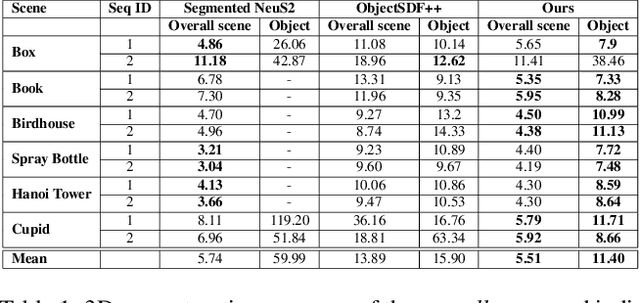

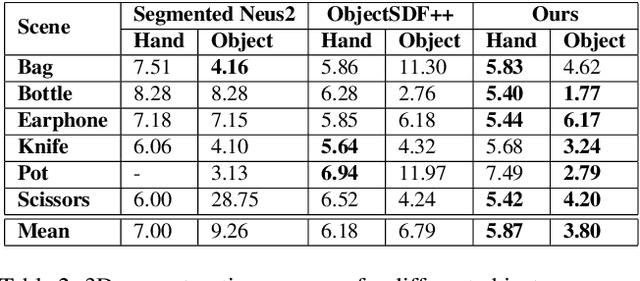
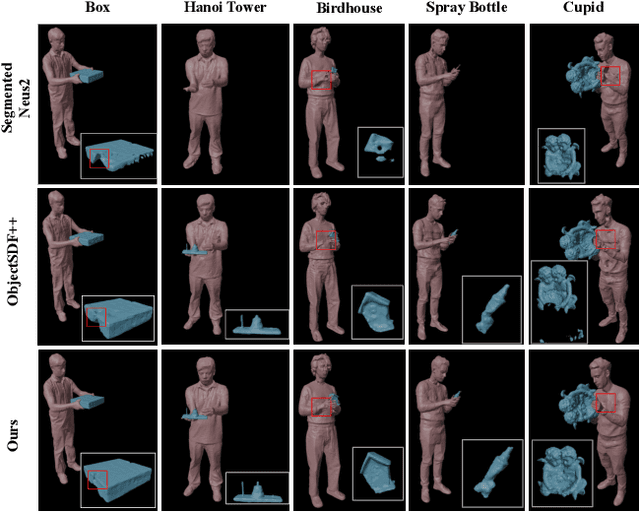
Abstract:Separable 3D reconstruction of multiple objects from multi-view RGB images -- resulting in two different 3D shapes for the two objects with a clear separation between them -- remains a sparsely researched problem. It is challenging due to severe mutual occlusions and ambiguities along the objects' interaction boundaries. This paper investigates the setting and introduces a new neuro-implicit method that can reconstruct the geometry and appearance of two objects undergoing close interactions while disjoining both in 3D, avoiding surface inter-penetrations and enabling novel-view synthesis of the observed scene. The framework is end-to-end trainable and supervised using a novel alpha-blending regularisation that ensures that the two geometries are well separated even under extreme occlusions. Our reconstruction method is markerless and can be applied to rigid as well as articulated objects. We introduce a new dataset consisting of close interactions between a human and an object and also evaluate on two scenes of humans performing martial arts. The experiments confirm the effectiveness of our framework and substantial improvements using 3D and novel view synthesis metrics compared to several existing approaches applicable in our setting.
EventEgo3D++: 3D Human Motion Capture from a Head-Mounted Event Camera
Feb 11, 2025Abstract:Monocular egocentric 3D human motion capture remains a significant challenge, particularly under conditions of low lighting and fast movements, which are common in head-mounted device applications. Existing methods that rely on RGB cameras often fail under these conditions. To address these limitations, we introduce EventEgo3D++, the first approach that leverages a monocular event camera with a fisheye lens for 3D human motion capture. Event cameras excel in high-speed scenarios and varying illumination due to their high temporal resolution, providing reliable cues for accurate 3D human motion capture. EventEgo3D++ leverages the LNES representation of event streams to enable precise 3D reconstructions. We have also developed a mobile head-mounted device (HMD) prototype equipped with an event camera, capturing a comprehensive dataset that includes real event observations from both controlled studio environments and in-the-wild settings, in addition to a synthetic dataset. Additionally, to provide a more holistic dataset, we include allocentric RGB streams that offer different perspectives of the HMD wearer, along with their corresponding SMPL body model. Our experiments demonstrate that EventEgo3D++ achieves superior 3D accuracy and robustness compared to existing solutions, even in challenging conditions. Moreover, our method supports real-time 3D pose updates at a rate of 140Hz. This work is an extension of the EventEgo3D approach (CVPR 2024) and further advances the state of the art in egocentric 3D human motion capture. For more details, visit the project page at https://eventego3d.mpi-inf.mpg.de.
 Add to Chrome
Add to Chrome Add to Firefox
Add to Firefox Add to Edge
Add to Edge